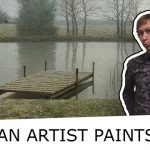How to glue canvas on a board at home?
Video lesson: How to glue canvas on a board at home? Summary:
You need:
- Firm hardboard
- Ordinary writing paper, cut into a size slightly smaller than the hardboard
- Canvas, cut into a size slightly smaller than the hardboard (to avoid accidental damage to its edge)
- Glue: PVA “Super” or another high quality type of PVA. I think in some countries Henkel’s or Elmer’s brand can be used, but I didn’t try it.
- Glue: PVA “Super”, half diluted by water
Steps:
- Coat the writing paper with the diluted PVA and give it couple minutes to soak in.
- Coat the hardboard with the diluted glue.
- Glue the paper on the hardboard, smoothing out it from the center to the sides and then from the center to the corners.
- Coat the other side of the hardboard with the undiluted PVA and glue the canvas in the same way, smoothing out from the center to the sides and then from the center to the corners.
- Put a sheet of writing paper down, and then put the hardboard with the paper side down on it.
- On the canvas of the top side of the hardboard we put another piece of writing paper and cover it with a weight.
- Suppose we have one more hardboard with canvas; we take away the weight, put additional writing paper on the first hardboard and put the new hardboard on it, with the canvas side facing down. On the second canvas we place another piece of writing paper. If we have third hardboard, we add writing paper again, so that in the end we have a paper for each side of each hardboard and the hardboards are placed canvas to canvas, paper to paper.
- We put the weight on top and leave them for twenty-four hours.
- After twenty-four hours we change the papers for fresh ones and leave the hardboards to like this. Let the weight to push them for a while longer.
*The purpose of the margins is to keep the edges of the canvas safe. Also, if you use a cassette holder (a box with carriers), you’ll keep the paint on a fresh study safe.
** For studies I usually use a glued canvas, not a canvas on a stretcher. It takes up less space and it’s easier to carry. For big paintings I use both, depending on the task. A canvas glued on hardboard is a hard surface which strongly resists a brush, and a canvas on a stretcher is elastic, so in each case you paint in a different way.
Recent Posts



